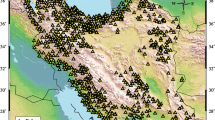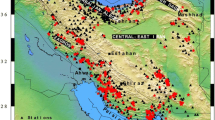Abstract
Strong motion data recorded by the Turkish national strong motion network has been compiled and processed systematically for the first time, together with detailed geophysical and geotechnical site measurements for all of its stations. The catalog information of 18 seismological agencies and other sources were examined to obtain reliable source, geometry, and distance parameters for each event. The high quality digital and analog strong motion data was processed by a uniform methodology to remove the high- and low-frequency noise. Currently, the seismological and spectral information of 4,607 strong motion records are available for use by earth scientists and earthquake engineers. In this article, we present the fundamental features of this database and explain our methodology in their calculation. We present several comparisons of our database with other related studies to verify our approach during the computational stage of the seismological parameters. The results confirm the reliability of our calculations. The database has also enabled us to derive empirical magnitude conversion relationships to estimate moment magnitude in terms of different magnitude scales. The article ends with a discussion of the likely improvements in the European accelerometric data through contributions from this strong motion database applicable for seismically active shallow-crust regions. The findings of this article emphasize the necessity of global strong motion databases in Europe for better estimation of seismic hazard in regions of similar seismotectonic environment.
Similar content being viewed by others
References
Abrahamson NA, Shedlock KM (1997) Overview. Seismol Res Lett 68:9–23
Akkar S, Bommer JJ (2006) Influence of long-period filter cut-off on elastic spectral displacements. Earthq Eng Struct Dyn 35:1145–1165
Akkar S, Bommer JJ (2007) Prediction of elastic displacement response spectra in Europe and the Middle East. Earthq Eng Struct Dyn 36:1275–1301
Ambraseys NN (2001) Reassessment of earthquakes, 1900–1999, in the Eastern Mediterranean and the Middle East. Geophys J Int 145:471–485
Ambraseys N, Durukal E, Free M (1993) Re-evluation of strong-motion data in Tukey. ESEE research report, No. 93/2. Imperial College of Science, Technology and Medicine, Civil Engineering Department, London
Ambraseys N, Smit P, Berardi R, Rinaldis D, Cotton F, Berge-Thierry C (2000) Dissemination of European strong-motion data. CD-ROM collection, European Commission, Directorate General XII, Science, Research and Development, Environment and Climate Programme, Bruxelles
Ambraseys N, Douglas J, Sigbjornsson R, Berge-Thierry C, Suhadolc P, Costa G, Smit PM (2004) Dissemination of European strong motion data volume 2. In: Proceedings of 13th world conference on earthquake engineering, Vancouver, BC, Canada, 1–6 August 2004, paper no. 32
Ateş RC, Bayülke N (1982) The 19 August 1976 Denizli, Turkey, earthquake: evaluation of the strong motion accelerograph record. Bull Seismol Soc Am 72:1635–1649
Atkinson GM, Silva W (2000) Stochastic modeling of California ground motions. Bull Seismol Soc Am 90:255–274
Aydan O, Hasgür Z (1997) The characteristics of acceleration waves of Turkish earthquakes. In: Proceedings of the 4th national confeernce on earthquake engineering, Ankara, Turkish National Committee of Earthquake Engineering, pp 30–37 (in Turkish)
Baba AB, Papadimitriou EE, Papazachos BC, Papaioannou CA, Karakostas BG (2000) Unified local magnitude scales for earthquakes of southern Balkan area. Pure Appl Geophys 157:765–783
Barka A, Reilinger R (1997) Active tectonics of the Eastern Mediterranean region deduced from GPS, neotectonic, and seismicity data. Ann Geophys 40:587–610
Bohnhoff M, Grosser H, Dresen G (2006) Straing partitioning and stress rotation at the North Anatolian fault zone from aftershock focal mechanisms of the 1999 Izmit Mw = 7.4 earthquake. Geophys J Int 66:373–385
Boore DM, Akkar S (2003) Effect of causal and acausal filters on elastic and inelastic response spectra. Earthq Eng Struct Dyn 32:1729–1748
Boore DM, Bommer JJ (2005) Processing of strong-motion accele-rograms: needs, options and consequences. Soil Dyn Earthqu Eng 25:93–115
Boore DM, Joyner WB, Fumal TE (1997) Equations for estimating horizontal response spectra and peak acceleration from western North American earthquakes: a summary of recent work. Seismol Res Lett 68:128–153
Bozkurt E (2001) Neotectonics of Turkey—a synthesis. Geodin Acta 14:3–30
Building Seismic Safety Council (BSSC) (2003) NEHRP recommended provisions for seismic regulations for new buildings and other structures, FEMA-450, 2003 revision. Federal Emergency Management Agency, Washington
Campbell KW (1997) Empirical near-source attenuation relationships for horizontal and vertical components of peak ground acceleration, peak ground velocity, and pseudo-absolute acceleration response spectra. Seismol Res Lett 68:154–179
Carroll RJ, Ruppert D (1996) The use and misuse of orthogonal regression in linear errors-in-variables models. Am Stat 50:1–6
Castellaro S, Bormann P (2007) Performance of different regression procedures on the magnitude conversion problem. Bull Seismol Soc Am 97:1167–1175
Castellaro S, Mulargia F, Kagan YY (2006) Regression problems for magnitudes. Geophys J Int 165:913–930
Çelebi M, Akkar S, Gülerce U, Şanlı A, Bundock H, Salkın A (2001) Main shock and aftershock records of the 1999 İzmit and Düzce, Turkey earthquakes. USGS/OFDA Project (USGS Project No.: 1-7460-63170), USGS Open-File Report 01-163
Chiou B, Darragh R, Gregor N, Silva W (2008) NGA project strong-motion database. Earthq Spectra 24:23–44
Delouis B, Giardini D, Lundgren P, Salichon J (2002) Joint inversion of InSAR, GPS, Teleseismic, and strong-motion data for the spatial and temporal distribution of earthquake slip: application to the 1999 İzmit mainshock. Bull Seismol Soc Am 92:278–299
Douglas J (2003) What is a poor quality strong-motion record? Bull Earthq Eng 1:141–156
Durukal E, Alpay Y, Biro T, Mert A, Erdik M (1998) Analysis of strong motion data of the 1995 Dinar, Turkey earthquake, second Japan–Turkey workshop: earthquake disaster prevention research in Turkey, 23–25 February 1998, Technical University of İstanbul
Erdik M (1984) Report on the Turkish earthquake of October 30, 1983. Earthq Spectra 1:151–172
Erdik M, Durukal E (2001) 1999 Kocaeli and Düzce, Turkey earthquakes: strong-ground motion, XV ICSMGE TC4 ‘Lessons learned from recent strong earthquakes, 25 August 2001, İstanbul, Turkey
Erdoğan Ö (2008) Main seismological features of recently compiled Turkish strong motion database. MSc thesis, Middle East Technical University, Ankara
Ergin M, Aktar M, Eyidoğan H (2004) Present-day seismicity and seismotectonics of the Cilician Basin: Eastern Mediterranean region of Turkey. Bull Seismic Soc Am 94:930–939
Frohlich C, Apperson KD (1992) Earthquake focal mechanisms, moment tensors, and the consistency of seismic activity near plate boundaries. Tectonics 11:279–296
Grünthal G, Wahlstrom R, Stromeyer D (2009) The unified catalogue of earthquakes in central, northern, and northwestern (CENEC)—updated and expanded to the last millennium. J Seismol 13:517–541
Gülkan P, Çeken U, Çolakoğlu Z, Uğraş T, Kuru T, Apak A, Anderson JG, Sucuoğlu H, Çelebi M, Akkar DS, Yazgan U, Denizlioğlu AZ (2007) Enhancement of the national strong motion network in Turkey. Seismol Res Lett 78:429–438
İnan E, Çolakoğlu Z, Koç N, Bayülke N, Çoruh E (1996) Earthquake catalogs with acceleration records from 1976 to 1996. General Directorate of Disaster Affairs, Earthquake Research Department, Ankara, Turkey, 98 pp (in Turkish)
Johnston AC (1996) Seismic moment assessment of earthquakes in stable continental regions—I. Instrumental seismicity. Geophys J Int 124:381–414
Joyner WB, Boore DM (1988) Measurement, characterization, and prediction of strong ground motion. Earthquake engineering and soil dynamics II. In: Proceedings of American society of civil engineers geotechnical engineering division specialty conference, Park City, Utah, pp 43–102
Kalafat D, Güneş Y, Kara M, Deniz P, Kekovalı K, Kuleli HS, Gülen L, Yılmazer M, Özel NM (2007) A revised and extended earthquake catalogue for Turkey since 1900 (Mw ≥ 4.0). Bosphorus University, İstanbul
Kalkan E, Gülkan P (2004) Site-dependent spectra derived from ground motion records in Turkey. Earthq Spectra 20:1111–1138
Kiratzi A, Louvari E (2003) Focal mechanisms of shallow earthquakes in the Aegean Sea and the surrounding lands determined by waveform modeling: a new database. J Geodyn 36:251–274
Özalaybey S, Ergin M, Aktar M, Tapırdamaz C, Biçmen F, Yörük A (2002) The 1999 Izmit earthquake sequence in Turkey: seismological and tectonic aspects. Bull Seismic Soc Am 92:376–386
Papazachos BC, Karakostas VG, Kiratzi AA, Margaris BN, Papazachos CB, Scordilis EM (2002) Uncertainties in the estimation of earthquake magnitudes in Greece. J Seismol 6:557–570
Rathje EM, Stokoe KH II, Rosenblad BL (2003) Strong-motion station characterization and site effects during the 1999 earthquakes in Turkey. Earthq Spectra 19:653–676
Sadigh K, Chang CY, Egan JA, Makdisi F, Youngs RR (1997) Attenuation relationships for shallow crustal earthquakes based on California strong motion data. Seismol Res Lett 68:180–189
Sandıkkaya MA (2008) Site classification of national strong-motion recording sites. MSc thesis, Civil Engineering Department, Middle East Technical University, Ankara
Sandıkkaya MA, Yılmaz MT, Bakır SB, Yılmaz Ö (2009) Site classification of Turkish national strong-motion stations. J Seismol (in press)
Scherbaum F, Schmedes J, Cotton F (2004) On the conversion of source-to-site distance measures for extended earthquake source models. Bull Seismol Soc Am 94:1053–1069
Scordilis EM (2006) Empirical global relations converting Ms and mb to moment magnitude. J Seismol 10:225–236
Ulusay R, Tuncay E, Sönmez H, Gökçeoğlu C (2004) An attenuation relationship based on Turkish strong motion data and iso-acceleration map of Turkey. Eng Geol 74:265–291
USGS (1999) Implications for earthquake risk reduction in the United States from Kocaeli, Turkey earthquake of August 17 1999. USGS Circular 1193, 65p
Wells DL, Coppersmith KJ (1994) New empirical relationships among magnitude, rupture length, rupture width, rupture area, and surface displacement. Bull Seismol Soc Am 84:974–1002
Yılmaz Ö, Savaşkan E, Bakır BS, Yılmaz MT, Eser M, Akkar S, Tüzel B, İravul Y, Özmen ÖT, Denizlioğlu AZ, Alkan A, Gürbüz M (2008) Shallow seismic and geotechnical site surveys at the Turkish national grid for strong-motion seismograph stations. In: 14th world conference on earthquake engineering, Beijing
Zaré M, Bard PY (2002) Strong motion dataset of Turkey: data processing and site classification. Soil Dyn Earthqu Eng 22:703–718
Author information
Authors and Affiliations
Corresponding author
Rights and permissions
About this article
Cite this article
Akkar, S., Çağnan, Z., Yenier, E. et al. The recently compiled Turkish strong motion database: preliminary investigation for seismological parameters. J Seismol 14, 457–479 (2010). https://doi.org/10.1007/s10950-009-9176-9
Received:
Accepted:
Published:
Issue Date:
DOI: https://doi.org/10.1007/s10950-009-9176-9




